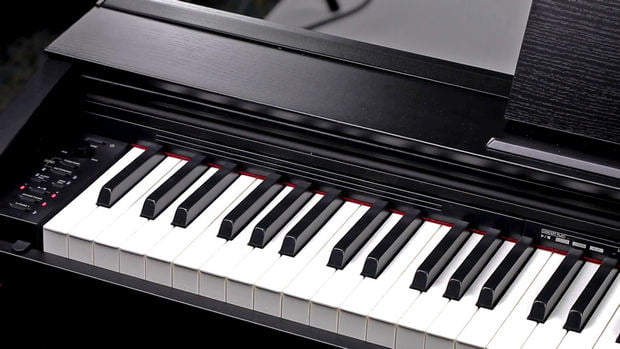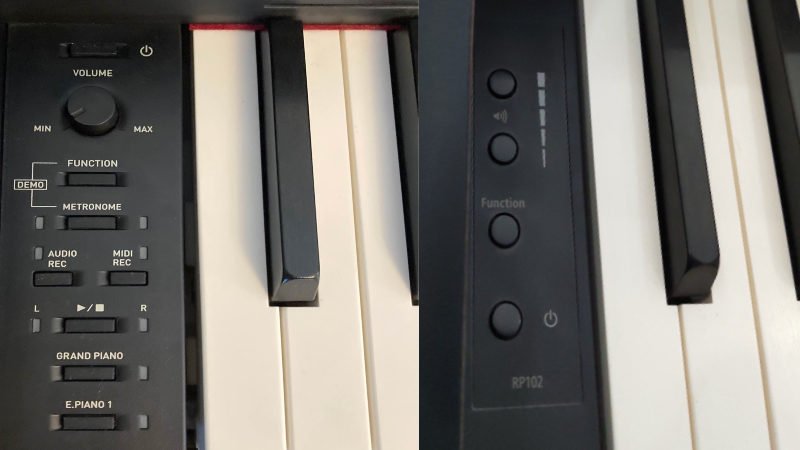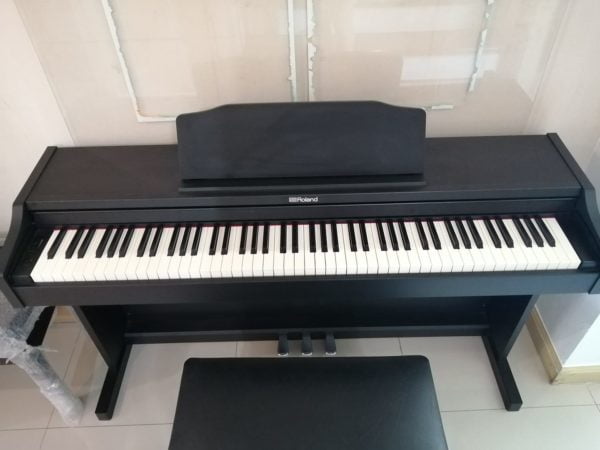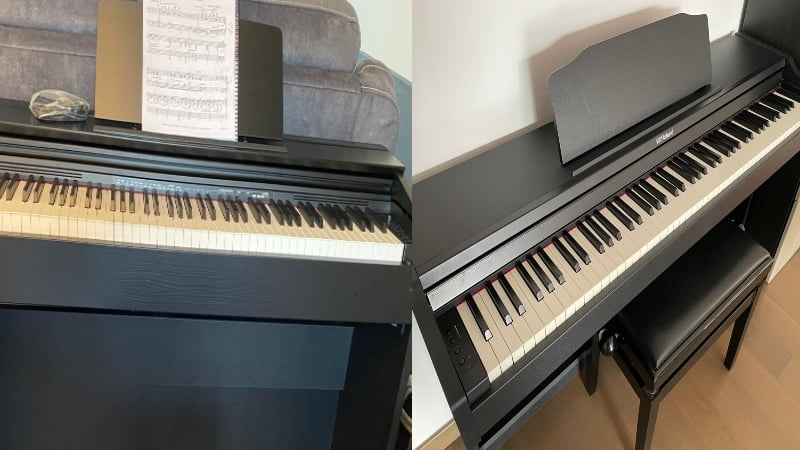In this Casio PX-870 vs Roland RP102 comparison, learn why I found the Casio PX-870 as the better investment!
One of my favorite digital console pianos that I always recommend for beginners and novices is the Casio PX-870. It’s affordable, comes with all the features you need, and has a rich high-quality sound library that is full of great voices.
However, when Roland RP102, I knew I had to check it out. As the entry-level model of the RP series, the Roland RP102 is very affordable. On top of that, it comes with a bunch of great features from a trusted brand.
And after creating this Casio PX-870 vs Roland RP102 comparison, I found that the extra hundred or so dollars for the Casio model is well-worth it. For a relatively small price difference, you get a bunch of sophisticated features and a much wider sound library than the Roland RP102, which is why I highly recommend the Casio PX-870 for anyone looking for a quality digital piano on a budget.
Casio PX-870 vs Roland RP102: Comparison Chart




Last update on 2024-07-25 / Affiliate links / Images from Amazon Product Advertising API
Casio PX-870 vs Roland RP102: The Features
After a pretty lopsided comparison of the features, I found that the Casio PX-870 won out in every category. And while the score at the end was 3-0 in favor of the Casio model, there were some bright spots of the Roland RP102 that still make it a high-quality piano on a budget.
Tone
The winner: Casio PX-870
Both of these pianos provided me with pretty good tones, which is why choosing a winner in this category was hard. But since I found that the Casio PX-870 was much more versatile with more voices, I ended up declaring it the winner.
+Tone Generator
One benefit of choosing either of these models is the top-quality voices. Whether you choose the Roland or the Casio, you’re ensured of very high-quality sounds that are well-worth your time and investment.
The Roland model uses the SuperNATURAL Piano Sound. This is a signature feature of many Roland models, and allows it to have a rich selection of piano voices. However, the one downside is that this generator only applies for the piano tones, so you may not get as much quality from the other voices.
With the Casio PX-870, you get the AiR Sound Source. This tone generator uses multi-layered samples to produce rich tones that travel through the air the same way acoustic piano sound waves do. That way, you get a much more realistic set of voices all throughout the piano.
When comparing the two, the difference was very minimal. However, I have to say that the Casio PX-870 did end up leaving this comparison with a slight edge.

+Sound Library
Both of these pianos offer a pretty wide sound library compared to other digital pianos. On the Roland, you get to choose from 15 different voices. This is a fair amount and is more than a lot of other digital console pianos, which gives you a fair amount of variety. Four of these sounds are piano sounds which use the SuperNatural Piano Sound generator, while the other 11 use more generic samples.
On the Casio, however, you get over 19 different voices. This allows you to choose between 5 acoustic and 4 electric piano voices, along with10 more unique voices such as strings, organs, and even a bass voice.
So, without a doubt, pianists get much more versatility if they choose the Casio PX-870 over the Roland RP102.
Feel & Playability
The winner: Casio PX-870
There were two distinct reasons the Casio PX-870 felt more realistic than the Roland RP102: hammer action and key texture. And when buying a digital piano, the feel is very important. As a pianist, you need a digital piano that feels similar to an acoustic piano, and the Casio PX-870 does a much better job at replicating the feel of an acoustic piano.
+Hammer Action
First off, the Casio PX-870 uses scaled hammer action while the Roland RP102 only uses fully-weighted keys. For a budget piano, it’s really nice that the RP102 has fully weighted keys. However, scaled hammer action does a better job of replicating the slight details of an acoustic piano’s action.
With the Casio PX-870 the lower keys will be slightly heavier to touch than the higher keys, which is how an acoustic piano is laid out. So, if you’re looking for more realism when you touch the piano keys, the Casio PX-870 is the one for you.
+Key Texture
In terms of key texture, I found that both pianos do a fairly good job. In fact, the Roland RP102 even comes with ivory touch keys, which contain a coating to better replicate the texture of real ivory keys. With that said, I still felt a fairly plastic texture when playing on the Roland.
With the Casio PX-870, the plastic feel was still there, but not as prominent as on the Roland. This is because it has coated black and white keys, so each of the piano keys can replicate the feel of an acoustic piano very well.
While there is no replacement for real wooden piano keys, both of these pianos give a pretty decent alternative.
Piano Features

The winner: Casio PX-870
When it came down to piano features, the Casio PX-870 showed that it’s worth the extra cost. It comes with a wider range of playing modes and better polyphony, which can make a huge difference for just about any pianist looking for a versatile digital piano.
+Playing Modes
The Roland RP102 comes with the essential playing modes for beginners. You get both dual and lesson mode with the Roland RP102. So, you can either blend two different voices together. Or, you can split the piano into two mini keyboards that you and the teacher can use alongside each other during piano lessons.
As the flagship Privia model, the Casio PX-870 also sports these features. However, the reason I chose the Casio as the winner is because of the recording and split modes on the piano. When performing, split mode is a great tool as it allows you to assign two different voices to either side of the piano.
This makes it seem like you’re playing two instruments at once and also allows you to fill up more sonic space. On top of that, you can also record your own playing and listen back for areas that need improvement. With that said, the recordings are still far from studio quality.
+Polyphony
In this day and age, polyphony isn’t that big a deal. This is because computing technology has gone so far in the past couple of years that it’s easy for brands to load their instruments with high maximum polyphony. So, it should be no surprise that the cheaper Roland RP102 comes with 128 note maximum polyphony, which is more than enough to handle a variety of dense chords.
However, the Casio PX-870 takes it a step further with 256 note maximum polyphony. This is because the piano uses multi-layered samples, which requires more polyphony to handle. So, while the difference isn’t that big, you still have more computing power and versatility if you choose the Casio PX-870 as your primary piano

Casio PX-870 vs Roland RP102: The Similarities
These are two very different pianos. Aside from being made by different brands, the Casio PX-870 is the flagship model while the Roland RP102 is the entry-level model. With that said, these are still two digital console pianos so they are bound to share a couple of similarities.
For starters, they both have adjustable touch response. So, if you need to make slight adjustments to the key sensitivity to compensate for lighter or heavier touches, you can do it with these pianos. On top of that, these are digital pianos with furniture stands that are designed to stay in one place.
So, if you’re looking for a piano you can bring around with you to gigs and performances, this may not be the option for you. However, if you need a solid piano that has realistic tones, realistic feel, and would look great in any room or performance space, you would do well with either the Casio PX-870 or the Roland RP102.
However, after going through all the tests, I have to say that the Casio PX-870 is still the more versatile model between the two.
Quick Rundown of the Casio PX-870
- The AiR engine provides highly-accurate grand piano sounds with seamless dynamics for a remarkably expressive and powerful performance
- The PX-870 features a variety of 19 instrument Tones, with the ability to layer and split them as needed. Touch Response - 3 sensitivity levels, Off
- With a generous 256 notes of polyphony, you can rest assured that even the most complex performances will sound perfectly natural
- The Tri-Sensor Scaled Hammer Action II keyboard has an incredible feel and captures the dynamics of a performance with unparalleled speed and accuracy
- The powerful 40-watt, 4-speaker system is designed to envelop the listener, audience and room with rich, detailed sound
Last update on 2024-07-25 / Affiliate links / Images from Amazon Product Advertising API
Quick Rundown of the Roland RP-102
- Quality piano performance and onboard practice features in an affordable, space-saving instrument
- Ideal as a first piano for the home, and also a great fit for lesson studios, practice rooms, and other music education settings
- Built-in Bluetooth MIDI allows wireless connection to popular apps on your smartphone or tablet such as GarageBand, piaScore, Sheet Music Direct, and many others
- Exclusive Roland Piano Partner 2 app provides easy access to advanced piano controls and numerous features for education, entertainment, and performance
- SuperNATURAL Piano technology delivers the authentic tone and response of an acoustic grand piano
Last update on 2024-07-25 / Affiliate links / Images from Amazon Product Advertising API
Product Videos
Related Articles to Casio Px 870
- Casio PX-870 vs PX-850: Finding the Best Privia Piano
- Casio PX-870 vs AP-470: What Makes the AP-470 Different?
- Casio PX-870 vs Casio AP-650: Which Casio Should You Get?
- Casio PX-870 Vs AP-270: Which Console Digital Piano Should You Get?
- Casio PX-870 Vs Yamaha YDP-163: Which Digital Piano Is The Better Option?
- Casio PX-870 Vs Yamaha YDP-143: A Look At Two Top Digital Console Pianos
- Casio PX-870 Vs Yamaha P-125: Should You Get A Portable Or Console Digital Piano?
- Casio PX-870 Vs Kawai KDP-110: The Best Digital Pianos In The Price Range?
- Casio PX-870 Vs Roland F140R: Which Is The Better Piano?
- Casio PX-870 Vs Roland FP-30: Which Piano Should You Choose?
- Casio PX-870 Vs 860: A Battle Of Two Privia Pianos
- Casio PX-870 Vs PX-780: Which Casio Model Is Best For You?
- Casio PX-870 Vs Yamaha YDP-164: Which Is The Better Choice For Beginners?
- Casio PX-870 Vs Yamaha YDP-144: Which Is The Better Console Digital Piano?
- Casio PX-770 Vs 870: Which Casio Console Digital Piano Is Better?
Reference:
- Casio PX-870: https://www.digitalpianoreviewguide.com/casio-px-870-review/
- Roland RP102: https://www.pianodreamers.com/roland-rp102-review/#Recording_and_Playback
Lulacruza is an electronic folk duo operating at the junction of the hypermodern and the ancient. Our music weaves together hypnotic female singing, South American folk instruments and electronic processing, while channeling pulsating waves from the source of creation.
Lalucruza is also a community where you can connect with other music lovers to collaborate, exchange ideas and share knowledge. A platform for who wants to learns the basics of playing piano, guitar, drum masters’ technique, etc.. is the premise of our website.
